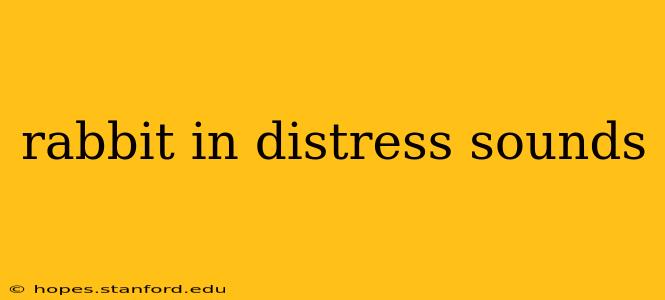Rabbits are sensitive creatures, and their well-being depends heavily on our ability to understand their communication. While they may not vocalize as much as dogs or cats, they use a variety of sounds to express their needs and distress. Learning to recognize these sounds is crucial for responsible rabbit ownership. This article will guide you through identifying sounds a rabbit in distress might make, and how to respond appropriately.
Common Sounds of a Rabbit in Distress
Rabbits in distress often communicate their discomfort through subtle and sometimes easily overlooked sounds. These aren't always loud cries; they can be quiet whimpers or changes in their typical vocalizations.
1. High-Pitched Screeches or Yells:
A sudden, high-pitched scream or yell is a serious indicator of pain or fear. This is often a response to a significant injury, a terrifying experience, or intense pain. Immediate veterinary attention is absolutely necessary in this situation.
2. Grunting or Grinding Teeth:
While occasional teeth grinding can be a sign of contentment, continuous or forceful grinding, especially accompanied by other distress signals, points to pain. Grunting sounds often accompany discomfort, particularly abdominal pain. This warrants immediate veterinary examination.
3. Whimpering or Soft Crying:
A soft whimper or cry, especially if repeated or persistent, indicates that your rabbit is uncomfortable or in pain. This could stem from various sources: a minor injury, an underlying health issue, or even stress. Observe your rabbit carefully for other symptoms and consider contacting your veterinarian.
4. Changes in Vocalization Patterns:
Even a change in your rabbit's typical vocalizations should raise concern. If your usually quiet bunny suddenly becomes more vocal, or a normally vocal rabbit falls silent, this could signal underlying distress. Pay close attention to the context and accompanying behavior.
Beyond Sounds: Recognizing Other Signs of Distress
While sounds are crucial, don't rely solely on auditory cues. Observe your rabbit's overall behavior for other signs of distress:
- Lethargy: Is your rabbit less active than usual? Are they spending more time lying down or huddled?
- Loss of Appetite: A significant decrease in food or water intake indicates a problem.
- Changes in Posture: Are they hunching, holding their body stiffly, or exhibiting unusual positions?
- Changes in Droppings: Changes in the frequency, consistency, or color of their droppings can signify internal problems.
- Abnormal Breathing: Rapid, shallow breathing or labored breathing is a serious sign requiring immediate veterinary care.
Responding to a Rabbit in Distress
Your prompt response is vital. If you suspect your rabbit is in distress, follow these steps:
- Assess the Situation: Carefully observe your rabbit for any injuries or obvious causes of distress.
- Provide Comfort: Offer a quiet, safe space where your rabbit can feel secure.
- Contact your Veterinarian: Don't delay; schedule an immediate appointment. Provide as much detail as possible about your rabbit's symptoms.
- Follow Veterinary Instructions: Adhere strictly to your veterinarian's instructions for treatment and care.
Understanding your rabbit's communication is vital to their well-being. Learning to recognize the sounds of distress, and responding promptly, can save your bunny's life. Always prioritize prompt veterinary attention when you suspect something is wrong. Your vigilance and responsiveness are key to ensuring a happy and healthy life for your beloved rabbit.

